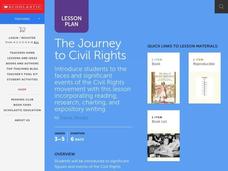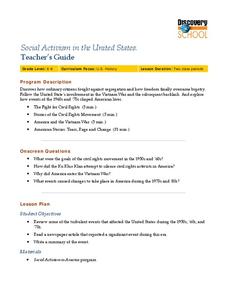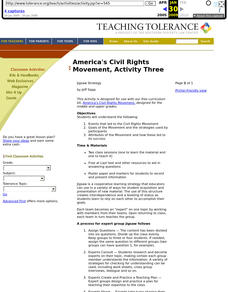Curated OER
Rosa Parks Changed the Rules
Students complete a diagram of the Montgomery bus that carried Rosa Parks into the history books. They read about Rosa Park's contributions to the Civil Rights movement. They role play Rosa Park's refusal to move to the back of the bus.
Curated OER
Lesson: Emory Douglas: Revolution in Our Time, Part 2
I love lessons like this because they let kids see the power of art, poetry, and activism in times of social injustice and unrest. They'll analyze the art used by Emory Douglas in the production of the Black Panther newspaper and...
Curated OER
Civil Services
Students investigate important themes, figures, and events of the Civil Rights Movement. They create a class mural that demonstrates their understanding of the continuing impact of the movement on American society.
Curated OER
Rights-Minded
Students expand their knowledge and understanding about the civil rights movement by investigating the lives of some of the people who contributed to it.
Curated OER
The Journey to Civil Rights
Young scholars investigate the concepts that surround the Civil Rights Movement. They conduct research with the help of the teacher and use chart paper to create posters about major people involved. Students also complete a timeline...
Curated OER
Unsung Heroes of the Civil Rights Movement
Students analyze historic rulings that played roles in the Civil Rights Movement. In this civil right lesson, students research Internet and print sources regarding Plessy v. Ferguson, Sipuel v. Board of Regents of the University of...
Curated OER
Rev. Joseph Lowery: What Makes a Civil Rights Leader?
Learners examine the attributes of civil rights leaders. In this Civil Rights Movement lesson, students design "body biographies" of selected civil rights leaders after they have conducted research and discussed the qualities of leaders.
Curated OER
Civil Liberties and National Security
Students identify the civil liberties outlined in the U.S. Bill of Rights and discuss the importance of these liberties in today's society. They research examples of when Congress has taken legislative action to protect national security.
Curated OER
The Civil Rights Act of 1964 and the Equal Employment Opportunity Commission
Young scholars discuss the Civil Rights Act of 1964 (and affirmative action) and how it has influenced American history in the decades since it's signing.
Curated OER
Melba Pattillo and Ruby Bridges: Two Heroes of School Integration
Learners put themselves in the shoes of students who integrated Little Rock High School in 1957-58. Note: The primary resources in this activity provide powerful and poignant descriptions of what those students faced.
Center for Civic Education
In the Shadows, Agents of Change
Most of your learners have probably heard of Martin Luther King, Jr., or Cesar Chavez, but could they also recognize the names of Betty Friedan or Dolores Huerta? Give your learners the opportunity to discover the many accomplishments of...
School Improvement in Maryland
Court Proceedings Civil Cases
What's the difference between civil and criminal law? How do the court proceedings differ in these two types of trials? How do the standards of proof differ? Why do these differences exist? As part of their examination of the US court...
Curated OER
Social Activism in the United States
Seventh graders explore the goals of the Civil Rights Movement of the 1950s and 1960s. In this US History lesson plan, 7th graders read a newspaper article that reported a significant event during this era. Students write a summary of...
Curated OER
GET UP, STAND UP: Fighting for Rights Around the World
Students explore basic human rights as they explore music by black artists. In this human rights lesson, students examine music as a cultural reflection of the justice issues. Students analyze Jamaican roots reggae of the 70s, American...
Curated OER
America's Civil Rights Movement, Activity Three
Learners investigate the events that led to the Civil Rights Movement and the attributes of the movement that led to its success using the Jigsaw method.
Curated OER
America's Civil Rights Movement, Cubing
Learners explore cubing as a graphic organizer to better explain the key concepts of the Civil Rights Movement and take positions on key concepts regarding the Movement.
PBS
The Goals of the March on Washington
Who else had a dream other than Martin Luther King, Jr.? Pupils explore civil rights leaders in a fourth lesson out of a series of five about people who paved the way to freedom for African Americans. The inquiry-based unit has your...
Stanford University
Observing Human Rights Day
How much intervention is appropriate for America to take in cases of human rights violations? Class members ponder a question that has lingered since the birth of America with a series of primary sources that reflect the degree to which...
Curated OER
Qualifying to Vote Under Jim Crow
Literacy tests, poll taxes, grandfather laws? Scholars study the systematic ways African-Americans were kept from voting even after it was made a law. They analyze a series of primary source documents, complete a worksheet, and engaged...
Stanford University
Martin Luther King, Jr. and Malcolm X: A Common Solution?
Much has been made of the differences between Martin Luther King, Jr. and Malcolm X. But was there any common ground between them? Class members reconsider what they think they know about these two civil rights leaders with biographical...
Curated OER
History in Literature - The House of Dies Drear
Hook your learners with a great project. They research the underground railroad and civil rights movement through literature, view the video The Underground Railroad: Escape from Slavery, and read the book House of Dies Drear in their...
Curated OER
Are Gay Rights "Special"?
Inspire critical thinking with this activity, which prompts students to compare lesbian, gat, bisexual, and transgender rights with the rights guaranteed by the Universal Declaration of Human Rights. By collecting topical articles about...
Curated OER
Rights in Early America
Get your historians to hop into someone else's 18th century shoes with a simulation on rights in early America. Each individual gets an identity card, indicating their race, gender, and status (slave or free). Areas around the room are...
National Endowment for the Humanities
Using Historic Digital Newspapers for National History Day
Your learners will take a trip through history as they peruse through historic digitalized newspapers, reading real articles from such historical periods in the United States as the Temperance movement and passage of the Thirteenth...

























